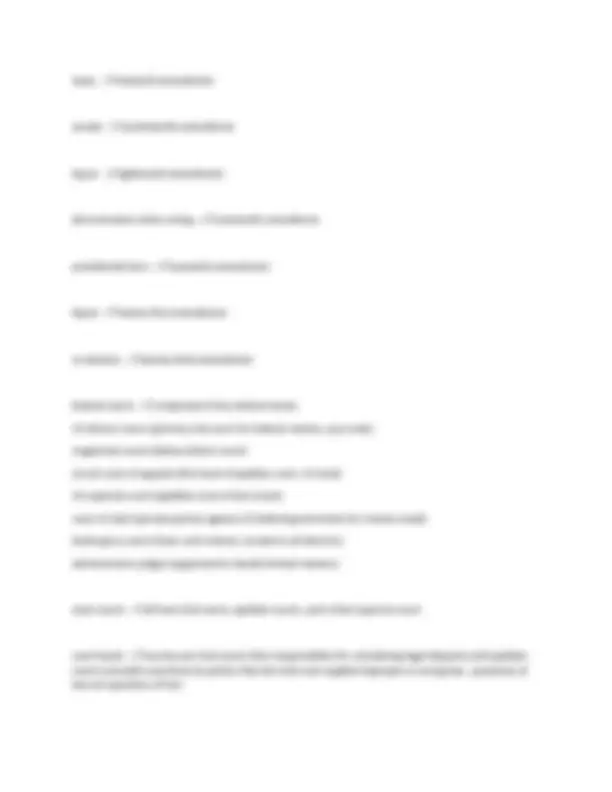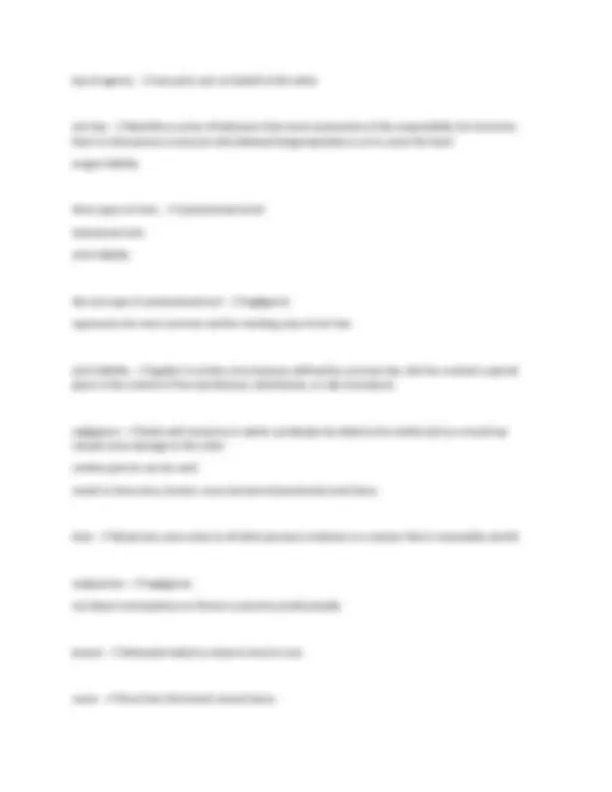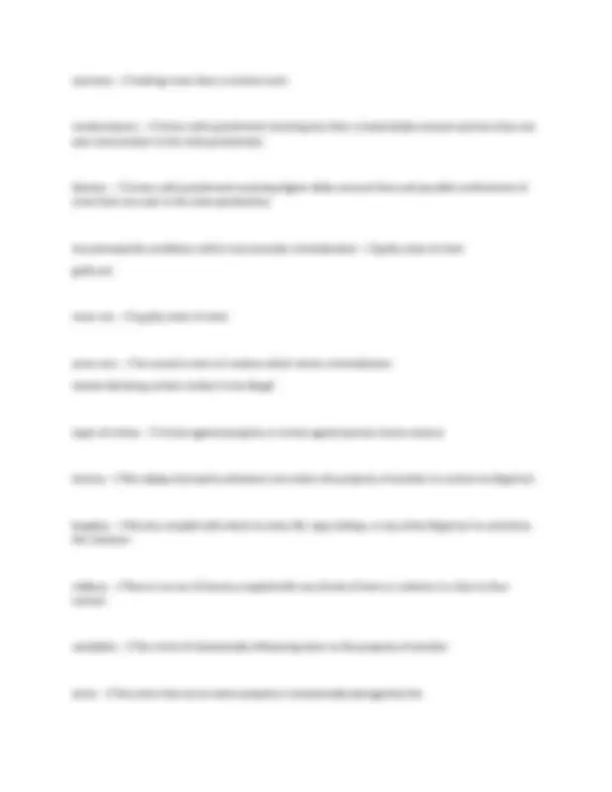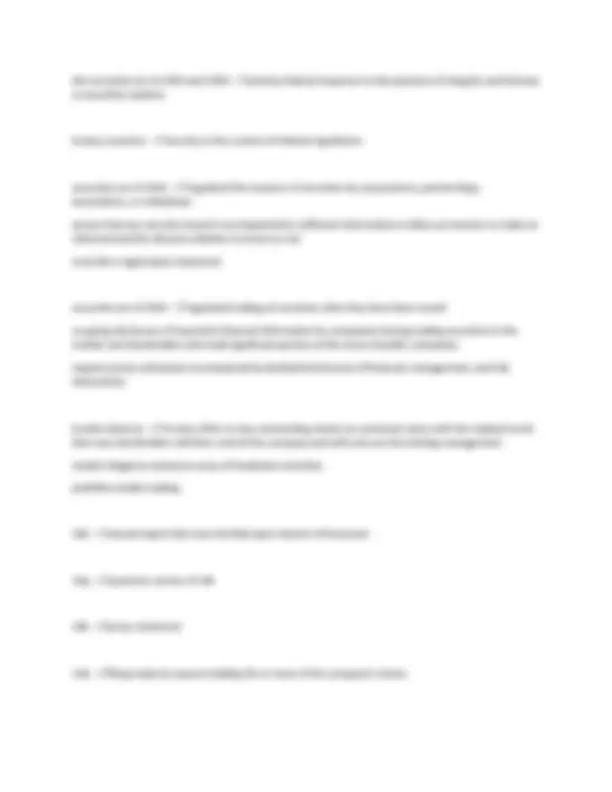











Study with the several resources on Docsity

Earn points by helping other students or get them with a premium plan


Prepare for your exams
Study with the several resources on Docsity

Earn points to download
Earn points by helping other students or get them with a premium plan
Community
Ask the community for help and clear up your study doubts
Discover the best universities in your country according to Docsity users
Free resources
Download our free guides on studying techniques, anxiety management strategies, and thesis advice from Docsity tutors
A comprehensive set of questions and answers related to business law, focusing on the us constitution, statutes, criminal and civil law, and various legal procedures. It covers key concepts such as due process, equal protection, and the rights guaranteed by the bill of rights, including freedom of religion, the right to bear arms, and protection against unreasonable searches and seizures. The material is designed to provide a clear and concise overview of fundamental legal principles and their practical applications, making it a valuable resource for students and professionals seeking to understand the basics of business law and the american legal system. It also touches on contract law, property law, and different forms of business organizations, offering a broad perspective on the legal landscape affecting businesses.
Typology: Exams
1 / 16

This page cannot be seen from the preview
Don't miss anything!










US Constitution is referred to as - ✅supreme law of the land statutes - ✅laws passed by LEGISLATIVE branch of government written statements of law contained in law codes criminal law - ✅deals with conduct requirements imposed by government on citizens by statute or ordinance where the conduct represents a societal interest in need of protection brought through prosecutors standard of proof (criminal law) - ✅requirements for preventing prevailing proof proof beyond a reasonable doubt civil law - ✅deals with the resolution of rights between citizens or between citizens and government where criminal matters are not involved created as statutes, regulations, or common law brought to court by one citizen (plaintiff) standard of proof (civil law) - ✅established by proof by a preponderance of the evidence stare decisis - ✅reliance on precedence case law - ✅common law and statutory construction are together referred to as... regulations - ✅laws made by the executive branch of government through the administrative bodies of that branch treaties - ✅international agreements reached between the US and one or more other countries
once confirmed by the legislative branch, considered to be law Administrative Procedure Act (APA) - ✅specifies that any rule-making (creation of regulations) must include specified amounts of public notice, acceptance and processing of public input, due consideration and fair process, and in some instances rights to appeal two organic levels of government - ✅federal and state the commerce clause - ✅gives the federal government the power to regulate interstate commerce, that is commerce that crosses state lines full faith and credit - ✅each state must reasonably honor the proper judgments and orders of other state courts fifth and fourteenth amendments - ✅require government act in all matters with due process due process - ✅government actions must follow a knowable process which assures fairness at certain levels fifth and fourteenth amendments equal protection - ✅fourteenth amendment taking of property - ✅fifth amendment self incrimination - ✅fifth amendment right to legal counsel - ✅sixth amendment search and seizure - ✅fourth amendment
taxes - ✅sixteenth amendment senate - ✅seventeenth amendment liquor - ✅eighteenth amendment discrimination when voting - ✅nineteenth amendment presidential term - ✅twentieth amendment liquor - ✅twenty first amendment re-election - ✅twenty third amendment federal courts - ✅comprised of four distinct levels: US district courts (primary trial court for federal matters, jury trials) magistrate courts (below district court) circuit court of appeals (first level of apellate court, 13 total) US supreme court (apellate court of last resort) court of claim (private parties against US federal government for monies owed) bankruptcy courts (hear such matters, located in all districts) administrative judges (appointed to decide limited matters) state courts - ✅all have trial courts, apellate courts, and a final supreme court court levels - ✅two key are trial courts (first responsibility for considering legal disputes) and apellate courts (consider assertions by parties that the trial court applied improper or wrong law...questions of law not questions of fact
courts that determine questions of law and questions of fact - ✅trial courts litigation process - ✅disputes are resolved in an enforceable manner types of procedures - ✅civil, criminal, and evidence types of procedures at the federal level - ✅federal rules of civil procedure, federal rules of criminal procedure, and federal rules of evidence jurisdiction - ✅principle that asks whether a court has the legal power to hear a particular matter venue - ✅asks which court among those having jurisdiction is the best court to hear the matter pleadings - ✅papers filed by counsel to the parties which activate, frame, and define the litigation the complaint - ✅the document filed by the plaintiff the answer - ✅the document filed by the defendant counterclaim - ✅defendant desires to sue the plaintiff, plaintiff must then file answer to the counterclaim motions - ✅included in pleadings, are requests made by one party to the court requesting certain action motion to dismiss - ✅made by defendant arguing that the court should throw out the lawsuit because it is somehow legally deficient motion for summary judgement - ✅claiming that there is no real dispute as to the facts and asking for the court to decide the case without a trial
two alternative methods of dispute resolution - ✅arbitration and mediation arbitration - ✅alternative to litigation which can be selected by parties but is not imposed by the government unless the parties so agree, expedited case can be advisory (not required to follow results) or binding (case result is enforceable) mediation - ✅occurs only by agreement of the parties, one or more neutral persons act as mediator mediator does not render any decision settlement four elements of an enforceable contract - ✅agreement consideration capacity legality agreement - ✅two or more parties actually reached an agreement contract law - ✅identifies the presence of an effective agreement by requiring an offer and acceptance acceptance - ✅timely and unequivocal rejection - ✅terminates offer counteroffer - ✅tenders back a different offer, rejects original offer consideration - ✅promise something of value to the other legality requirement - ✅an agreement between two or more parties may not result in a legally binding contract where the object of the agreement is illegal
capacity - ✅must have mental capacity sufficient to support the establishment of a binding agreement are afforded the capacity to enter into a binding contract form/fifth element that must be satisfied - ✅rendered in writing, statute of frauds secured transaction - ✅one created when a creditor makes a loan to a debt or in exchange for the debtor's pledge of personal property as security collateral - ✅pledged property two types of property - ✅real and personal real property - ✅land personal property - ✅all tangible or intangible property easements - ✅create a right to use property for a specific purpose licenses - ✅legal right to enter upon property and take valuable items from the property for economic harvest possession - ✅lessee/lessor relationship, landlord/tenant ownership - ✅most complete right to property fee simple - ✅most complete form of ownership implies permanent right to control use and possession, including right to transfer or bequest ownership upon death
law of agency - ✅one party acts on behalf of the other tort law - ✅identifies a series of behaviors that merit assessment of the responsibility for economic harm to that person or persons who behaved inappropriately so as to cause the harm assigns liability three types of torts - ✅unintentional tords intentional torts strict liability the one type of unintentional tort - ✅negligence represents the most common and far reaching area of tort law strict liability - ✅applies in certain circumstances defined by common law, but has evolved a special place in the context of the manufacture, distribution, or sale of products negligence - ✅deals with instances in which somebody has failed to be careful and as a result has caused some damage to the other careless person can be sued needs to show duty, breach, cause (actual and proximate) and injury duty - ✅all persons owe a duty to all other persons to behave in a manner that is reasonably careful malpractice - ✅negligence not about incompetence or fitness to practice professionally breach - ✅defendant failed to observe level of care cause - ✅show how the breach caused injury
two types of cause - ✅actual (fact) and proximate actual cause - ✅scientific or physical causation standard of actual cause is often articulated as a but for standard proximate causation - ✅legal artifice designed to exclude from the tort of negligence improbable or unforeseeable chain of causation demands that the plaintiff show a causal like (chain) that was reasonably forseeable injury - ✅bodily injury, medical rehabilitation costs, ambulance fees, pain and suffering, loss of the ability to work and loss of future income reasonably expected punitive number/damages - ✅paid as a deterrence to future persons to stop such action from happening again only be awarded where the defendant's conduct was outrageous or grossly negligent comparative negligence - ✅contemplates the very real possibility that multiple causes contribute to the occurrence of an accident or event, and that often some part of the total causation package is represented by careless conduct by the plaintiff requires that the total injury expressed in monetary damages the plaintiff can only recover from the defendant that percentage of that total cause doctrine of assumption of risk - ✅holds that if a plaintiff could have acted in a way which would have averted the injury caused by the defendant's negligence, the plaintiff would not recover compensation conversion - ✅the civil equivalent of theft assault - ✅act of putting someone in fear of bodily harm battery - ✅actual act of instilling bodily harm to another without privilege or consent
warranty - ✅nothing more than a contract term misdemeanors - ✅crimes with punishment involving less than a stated dollar amount and less than one year incarceration in the state penitentiary felonies - ✅crimes with punishment involving higher dollar amount fines and possible confinement of more than one year in the state penitentiary two prerequisite conditions which must precede criminalization - ✅guilty state of mind guilty act mens rea - ✅a guilty state of mind actus reus - ✅an actual or item of conduct which merits criminalization statute declaring certain conduct to be illegal types of crimes - ✅crimes against property or crimes against person (more serious) larceny - ✅the taking of property whenever one enters the property of another to commit an illegal act burglary - ✅larceny coupled with intent to steal, kill, rape, kidnap, or any other illegal act to constitute this violation robbery - ✅there is an act of larceny coupled with any threat of harm or violence in a face to face context vandalism - ✅the crime of intentionally influencing harm to the property of another arson - ✅the crime that occurs when property is intentionally damaged by fire
fraud - ✅contemplates the illegal taking of property of another through the use of trick, misrepresentation or deceit homicide - ✅the wrongful and unprivileged taking of a human life two types of homicide - ✅manslaughter murder murder - ✅more serious offense occurs when a life is taken without a legal right to take that life, but with premeditation and with malice manslaughter - ✅life is taken without a legal right to take that life and without prior planning and malice the sherman act - ✅arguably more important passed in 1890 section 1 limits combination in restraint of trade section 2 limits monopolies the clayton act - ✅passed in 1914 illegal interlocking of directorates prohibition of mergers and acquisitions which lessen competition and price discrimination hertindahl-hirshman index (HHI) - ✅used by the government to determine which mergers and acquisitions to oppose (horizontal mergers, seldom vertical mergers) exempt businesses - ✅labor unions, baseball, state and local government activities, export activities, certain agricultural activities, intrastate, and regulated industries including utilities
8k - ✅filing made by company any time there is significant material information or significant material development which investors need to know sarbanes oxley act - ✅bring integrity to accounting, disclosure and management of publicly traded companies national environmental policy act (NEPA) - ✅applies to actions of the federal government procedural mechanism is an environmental impact statement (EIS) clean air act - ✅sets air emission standards limiting the amount of pollutants that can be emitted into the air clean water act - ✅relates to discharges of pollutants into navigable or other waterways national pollution discharge elimination system (NPDES) - ✅no pollution may be discharged into waterways without a permit comprehensive environmental recovery, compensation, and liability act (CERCLA) - ✅provisions for preventing and remediating environmental spills historical industrial pollution resource conservation and recovery act (RCRA) - ✅addresses issues of solid waste which are hazardous toxic substances control act (TSCA) - ✅addresses toxic substances chapter 7 liquidating bankruptcy - ✅available to individuals, partnerships, and corporations chapter 11 reorganization bankruptcy - ✅attempt to reorganize and save the business chapter 13 wage earner's bankruptcy - ✅give individuals a chance for a fresh start